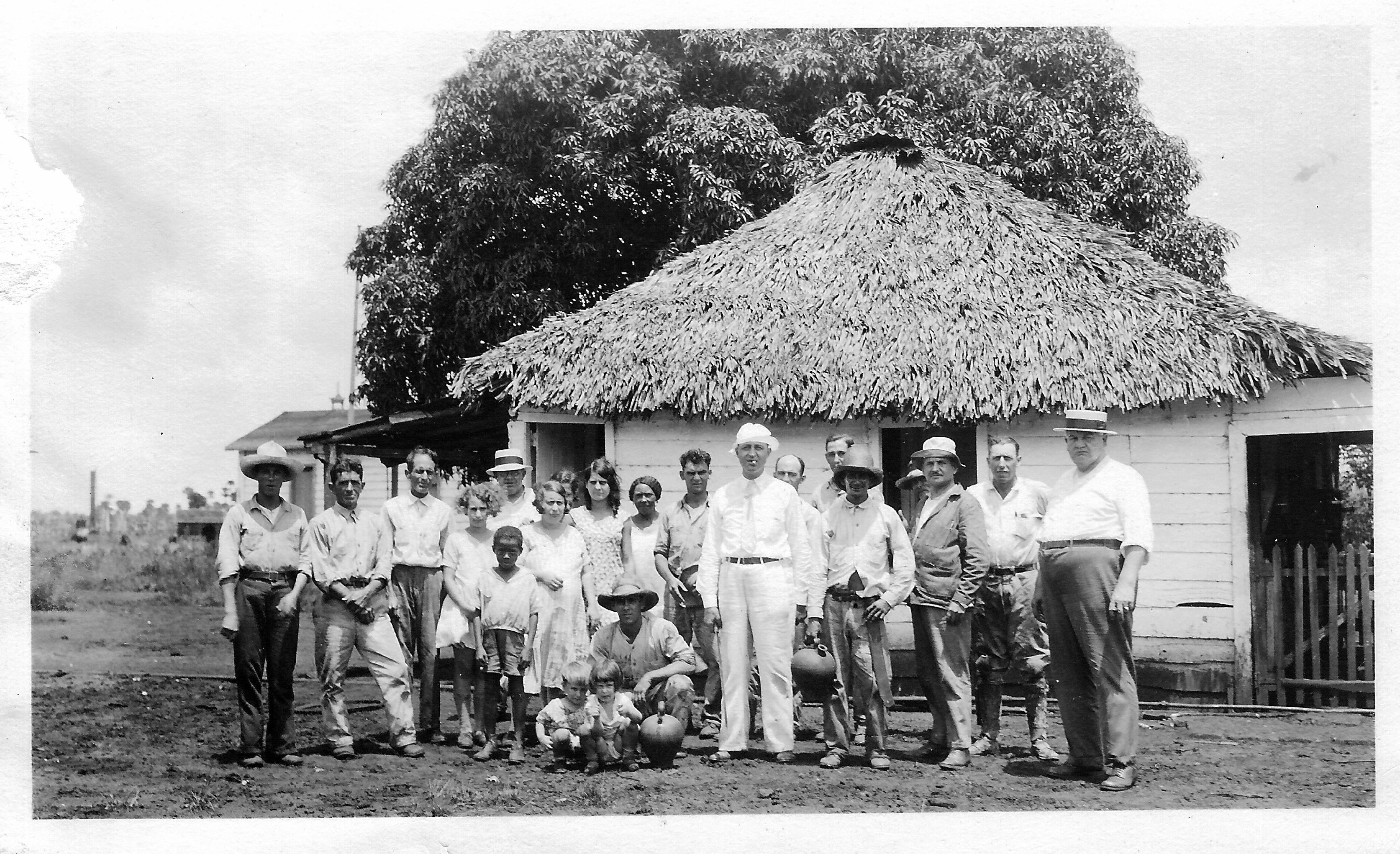
Motembo Crew in front of hut in pre-Castro Cuba circa 1932

San Juan De Motembo Oil Properties
The Motembo natural gas field is situated in the northern part of the Province of Santa Clara, about eight miles from the Gulf of Mexico and some ten or twelve miles from the towns of San Jose de los Ramos, in the Province of Matanzas, and Playas de Sierra Morena, in the Province of Santa Clara. Within a radius of 30 miles of the field there is a population of approximately 250,000. The United Railways of Havana and Junction branch line come within four miles of the field. The railroad journey requires about five hours.
The Motembo field was discovered in 1880 while excavating for a water well. A Chinese laborer struck a match while working at a depth of 80 feet and was killed as a result of a terrific explosion. The gas burned for several months before it was extinguished and has been flowing steadily from the original excavation every since.
In 1920, an exhaustive report of the Motembo property was made by a technical and industrial mining commission, composed of eight geologists and engineers, headed by Dr. Corral, Director of the Cuban Bureau of Mines. This report is available at the Bureau of Mines as a government publication and deals at length with all phases of the Motembo field, development recommendations, chemical analyses of the product, refining and condensing tests, etc. There is a further report by S. G. Cordero, Oil Engineer of the Mexican Government, who spent three months in resident study of the Motembo structure. Nos. 12, 13 and 14 of the Bulletin de Mines of the Cuban Bureau of Mines deal with the Motembo field.
The product of the Motembo field is a naphtha gasoline, clear and crystalline in substance. It can be used directly in internal combustion engines without distillation or skinning. It is markedly superior to ordinary gasoline. It can also be used as a substitute for turpentine in the manufacture of paints, varnishes and enamels. It is also a powerful solvent.
It is stated that present and future production can be entirely sold, under contract, at well for not less that 25 cents per gallon up to a production of 300,000 per month. The West Indian Oil Refining Co., of Cuba, a subsidiary of the Standard Oil Co., took the entire present production for a period of over two years. The Dutch Shell interests would also be interested in contracting for the output of the field.
The owners of the property have been successful in obtaining from
The Cuban Government exemption for the gasoline produced at Motembo from the road tax of 10c per gallon levied on all gasoline sold in Cuba, exemption being granted by reason of the fact that Motembo gasoline is a natural and not a chemically refined product.
In addition to the Motembo property, there has already been acquired all the adjoining acreage.
The following are excerpts taken from the report issued in 1928 by Sr. Roque Allende, Geologist of the Cuban Bureau of Mines:
“Well No. 1—1100’ deep. Production small but steady, roughly 2,000 gallons per month. This first exploration well is located near the western boundary of the property and beyond the present limits of the producing area. It shows water seepages of the kind found in Tampico wells.
(Note—recent visits to Well No. 1 found a gasoline-naptha
column in the well of 910 feet, and in the opinion of experienced
oil Men that if the well were pumped regularly it would maintain
a production of not less that 500 gallons per day.)
“Oct. 18, 1919. Well No. 2—883’ deep, with 10 inch casing. Located at a distance of 90 meters from No. 1 well, in a straight line to the center of the property, in a northeasterly direction. It was drilled in 1920. The naptha-gasoline flowed by its own pressure until a fire, caused by a lighted match near the well, destroyed all the equipment and 50,000 gallons of naphtha-gasoline ready for shipment. This well was controlled some time later and new machinery installed. Since then it has produced over a million gallons of naphtha-gasoline. The normal monthly production, with no regular pumping schedule, is from 6,000 to 8,000 gallons per month. The gas from this well has been piped to all of the buildings and outhouses, and has been used for power and drilling operations.
“Sept. 22, 1920. Well No. 3—873’ deep. It is situated about the same distance to the east from No. 1, as the No. 2 well. Naphtha flowed by its own pressure and the drillers discontinued their work under a proviso of the contract, and therefore, this well has never been finished. It is believed that the extreme gas pressure produced is an indication of a much larger output than any other well drilled so far.
(Note—It is now planned to drill No. 3 well deeper—about 30 feet
where it is thought a production of 5,000 gallons per day, or greater
will be obtained.)
“Mar. 8, 1921. Well No. 4, same distance as No. 3 toward the southeast.
1600’ deep. Flowed by its own pressure producing 5,000 gallons per day,
when they dropped the casing, which fell 400’ thus plugging the hole.
Copyright (c) Stephen Payne 2007